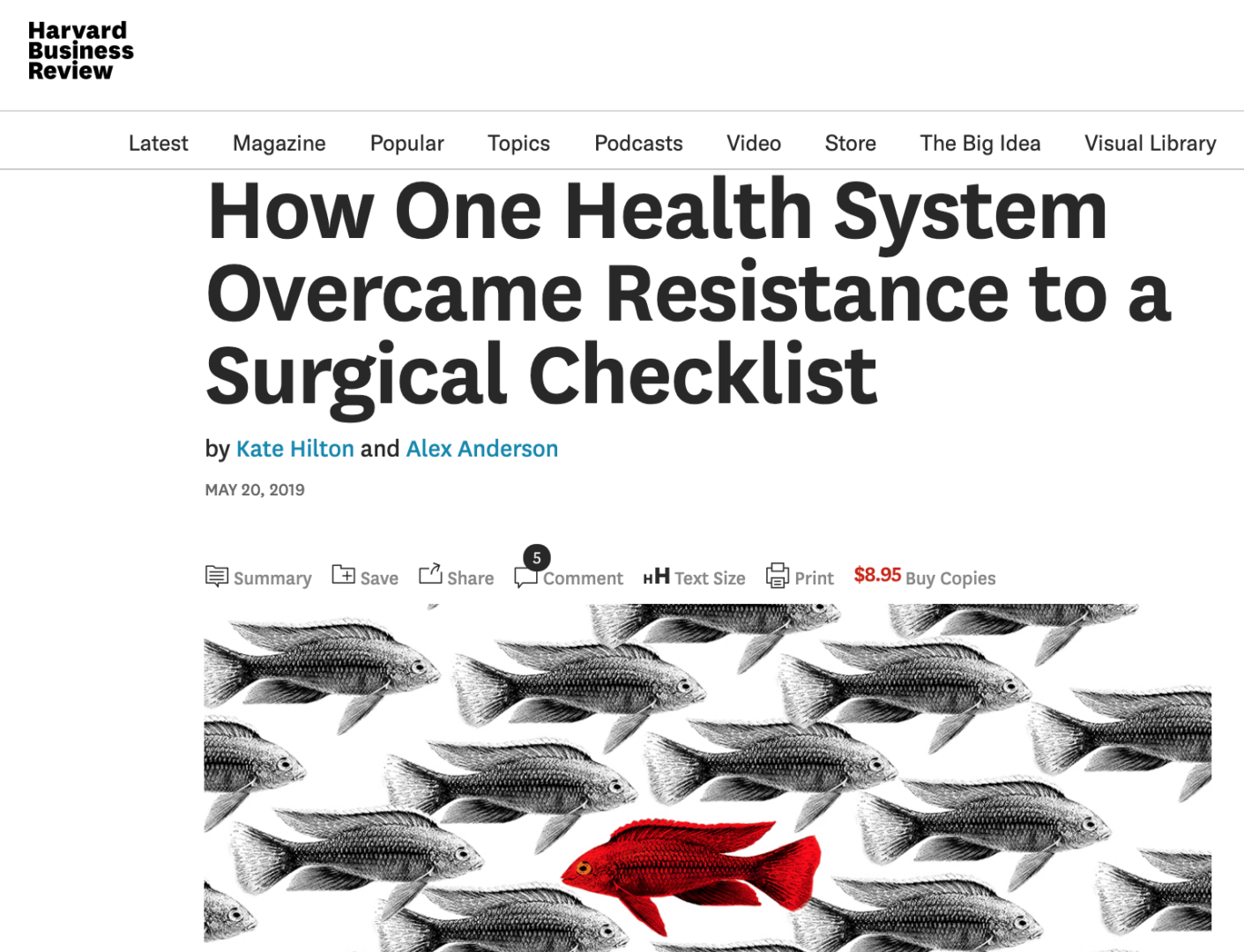Here is an article that caught my eye recently, from HBR:
“How One Health System Overcame Resistance to a Surgical Checklist“

Seeing the word “resistance” always makes me wonder if the health system in the article was blaming surgeons (or others) for being “resistant.” As I've written about before, blaming others is a really poor strategy for getting others to embrace change.
The authors of the HBR article seem to agree:
“The natural reaction by leaders at all levels charged with implementing change is to fight the resisters. But research and the experiences of some organizations suggest that embracing those who resist
change the most — empathizing with them, identifying the sources of their resistance, and helping them see change as positive — is far more effective.”
Those thoughts remind me, in a way, of the “motivational interviewing” style of counseling and managing. Of course, helping people accept change is more complicated than knocking down sources of resistance. We have to also help people strengthen their commitment to change, evoking and strengthening intrinsic motivation.
The article discusses how they increased acceptance, and they report:
“[McLeod Regional Health System] now use the checklist for 100% of surgical cases.”
Is that a real “100%” — or a “reported 100%” or an “observed 100%”? Those might not be the same thing.
This has been done to what benefit?
“Since implementing the checklist, McLeod's 30-day surgical mortality rate has dropped by nearly one-third; surgical teams' productivity has increased (by 7.5 hours per case), saving more than $4 million annually; and a greater volume of surgical cases, combined with the higher operating room throughput, has generated more than $3 million in additional revenue annually. Surgical team members also report that their job satisfaction has risen and there's a stronger culture of safety in which everyone, regardless of their position, feels they can speak up to call attention to and take action as safety issues arise.”
The article talks about how surgical checklists are logical and evidence based… but people still “resist.” People are complicated. That's why we have to help them and work with them instead of just labeling or blaming them.
For the first 18 months, acceptance rates hovered at about 30% at McLeod.
Then, they tried three approaches that are elaborated on in the piece:
- Don't fight the resistors
- Stop telling people what changes to make
- Focus on the people who already are committed to change
All of those three approaches require conversations about change. Again, that reminds me of the M.I. approach.
Communication can't just be a one-way mandate. Leaders need to invite people to share their motivations and challenges. Hopefully, the discussion goes in a direction that allows people to strengthen their motivation. TELLING is tempting, but it might result only in superficial compliance (with people reporting that checklists are being used, even if they are really not).
What do you think of the article? How does this line up with your experiences?
Please scroll down (or click) to post a comment. Connect with me on LinkedIn.
Let’s work together to build a culture of continuous improvement and psychological safety. If you're a leader looking to create lasting change—not just projects—I help organizations:
- Engage people at all levels in sustainable improvement
- Shift from fear of mistakes to learning from them
- Apply Lean thinking in practical, people-centered ways
Interested in coaching or a keynote talk? Let’s start a conversation.








![When Was the Last Time a Leader Around You Admitted They Were Wrong? [Poll]](https://www.leanblog.org/wp-content/uploads/2025/07/Lean-Blog-Post-Cover-Image-2025-07-01T212509.843-100x75.jpg)

RE: “Leaders need to invite people to share their motivations and their challenges.” It would be nice if the reverse were also done, because workers don’t understand top leaders: Leaders sharing their motivations and their challenges would help expose gaps that might then be closed. The motivations and challenges of a typical hospital CEO and a typical physician, nurse, or lab tech are surely different.
Great post Mark,
I find that the distinction between push (telling) and pull (I want to do this) is really powerful. Your mention of motivational interviewing is important, no one but the person themselves is going to buy into change and we won’t get success unless that buy in happens.
Also, focussing on those who want to change has great benefit, not only do those who want to change get support and make positive change, but also these people and their improvements become the role model, to show those resisters that change can be a positive thing.
Thanks, Kevin.
One thing I’d add is that a very powerful lesson from Motivational Interviewing is that people in a workplace aren’t easily put into binary categories of “want to change” and “don’t want to change.”
Most employees will be “ambivalent” meaning that they have motivations and reasons to change… AND they have reasons to maintain the status quo.
So, we can worth with people even if they’re not yet fully committed to change. We can help them decide if they want to strengthen their personal commitment to change (which doesn’t mean manipulating them, of course).